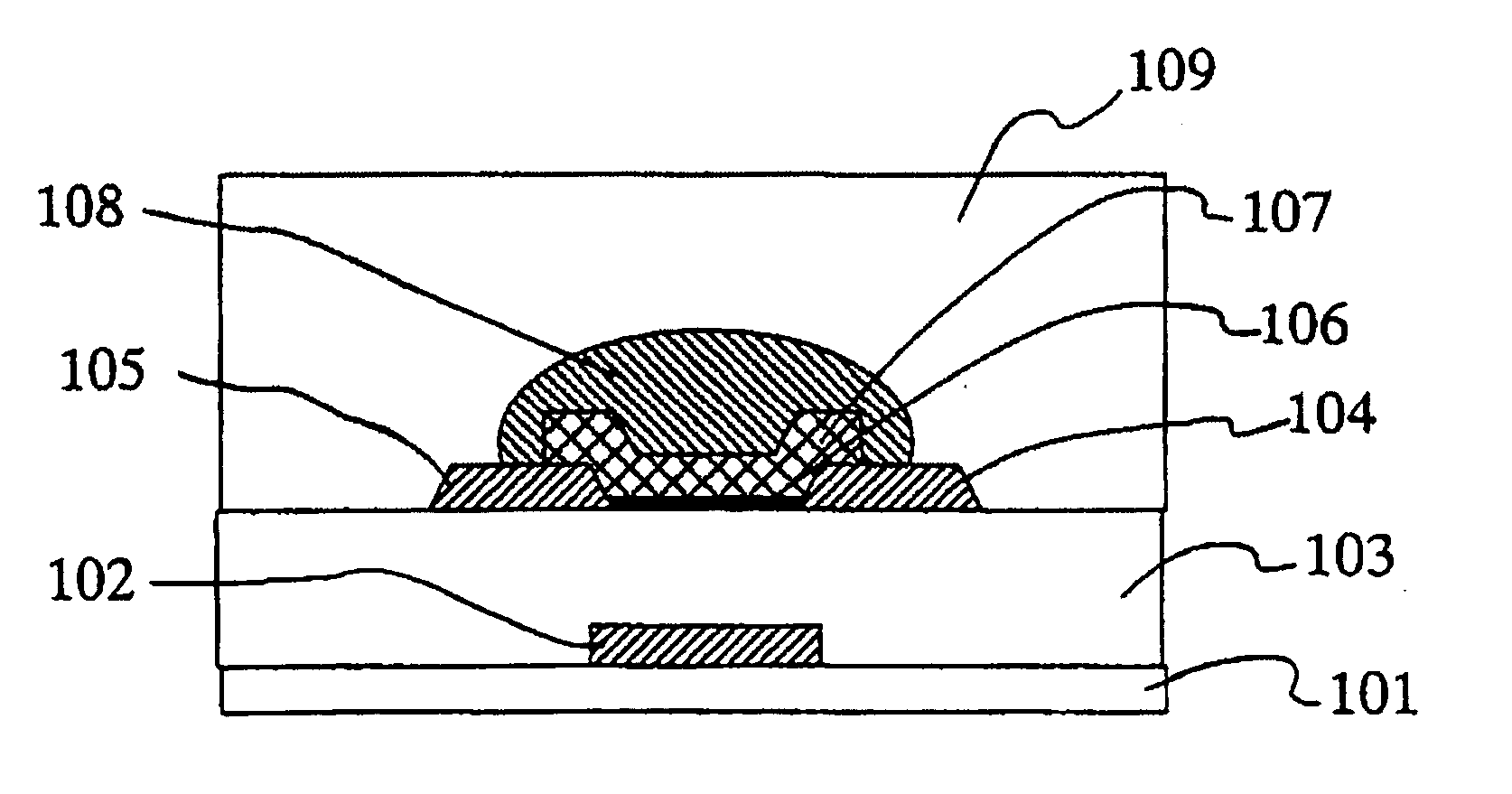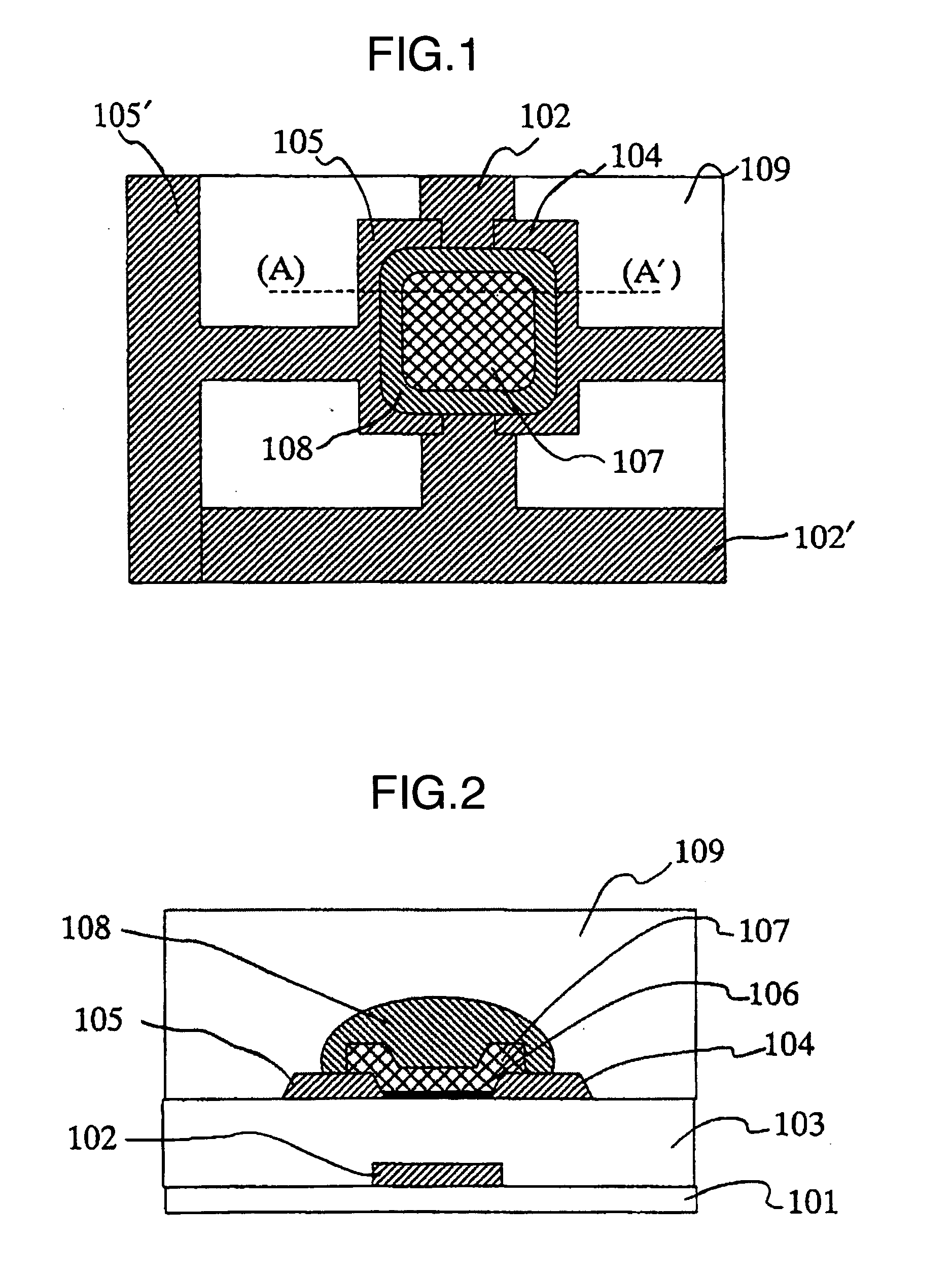Thin film transistor and semiconductor device using the same
a thin film transistor and semiconductor technology, applied in the field of thin film transistors, can solve the problems of deterioration or fear of physical peeling of the semiconductor layer, and unavoidable exposure of the side surfaces of the semiconductor
- Summary
- Abstract
- Description
- Claims
- Application Information
AI Technical Summary
Benefits of technology
Problems solved by technology
Method used
Image
Examples
example 1
[0061] The first example of the present invention is described with reference to FIG. 1 to FIG. 4. FIG. 1 shows the planar schematic view of the organic thin film transistor using the present invention, and FIG. 2 shows the sectional schematic view of the organic thin film transistor using the present invention. FIG. 2 shows the section of (A)-(A′) in FIG. 1.
[0062] A glass substrate was used as the dielectric substrate 101. The dielectric substrate 101 can be selected from a broad range of dielectric materials. Specifically there can be used inorganic substrates such as quartz, sapphire, silicon and the like; and organic plastic substrates such as acrylic, epoxy, polyamide, polycarbonate, polyimide, polynorbornene, polyphenylene oxide, polyethylene naphthalenedicarboxylate, polyethylene terephthalate, polyethylene naphthalate, polyarylate, polyether ketone, polyether sulfone, polyketone, polyphenylene sulfide and the like. In addition, a film such as silicon oxide, silicon nitride ...
example 2
[0071] The second example of the present invention is described with reference to FIG. 5. FIG. 5 shows the sectional schematic view of the organic thin film transistor using the present invention. A glass substrate was used as the dielectric substrate 101. The dielectric substrate 101 can be selected from a broad range of dielectric materials similarly to Example 1. Thereon were formed the gate electrode 102 and the scanning wiring 102′ of Cr at a thickness of 150 nm. The gate electrode 102 and the scanning wiring 102′ are not particularly limited as long as they are conductive materials, and can be selected from a broad range of materials similarly to Example 1. Next, as the gate dielectric layer 103, SiO2 film of 300 nm in thickness was formed by chemical vapor deposition. The gate dielectric layer 103 can be selected from a broad range of dielectric materials similarly to Example 1. Next, the surface of the above gate dielectric layer was modified with the monomolecular layer 106...
example 3
[0075] The third example of the present invention is described with reference to FIG. 6. FIG. 6 shows the sectional schematic view of the organic thin film transistor using the present invention. A glass substrate was used as the dielectric substrate 101. The dielectric substrate 101 can be selected from a broad range of dielectric materials similarly to Example 1. Thereon were formed the source electrode 104 / drain electrode 105 and signal wiring 105′ of Au at a thickness of 50 nm. The materials of source electrode 104 / drain electrode 105 and signal wiring 105′ are not particularly limited as long as they are conductive materials, and can be selected from a broad range of materials similarly to Example 1. Next, a soluble pentacene derivative was applied by ink jet method and fired to form the semiconductor layer 107 of 100 nm in thickness. The semiconductor layer 107 can be selected from a broad range of materials similarly to Example 1.
[0076] Next, a polyvinyl alcohol, in which an...
PUM
 Login to View More
Login to View More Abstract
Description
Claims
Application Information
 Login to View More
Login to View More - R&D
- Intellectual Property
- Life Sciences
- Materials
- Tech Scout
- Unparalleled Data Quality
- Higher Quality Content
- 60% Fewer Hallucinations
Browse by: Latest US Patents, China's latest patents, Technical Efficacy Thesaurus, Application Domain, Technology Topic, Popular Technical Reports.
© 2025 PatSnap. All rights reserved.Legal|Privacy policy|Modern Slavery Act Transparency Statement|Sitemap|About US| Contact US: help@patsnap.com



